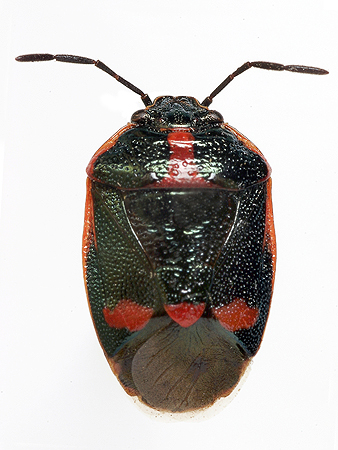Pests
Eurydema oleracea L. . Rape Bug
Systematic position.
Class Insecta, order Heteroptera, family Pentatomidae, subfamilyPentatominae, genus Eurydema.Biological group.
Oligophagous pests of cruciferous cultures.Morphology and biology.
Body of adult bug is flat, 5-7 mm in length and 3-4 mm in width, black and shining. One oval spot is present on the top of scutum and on each elytron, in addition to a longitudinal stripe on pronotum. Their color is yellow in all young winged imagos, changing later into white or red (two morphs of the species). The color of abdomen changes at the same time from straw to black. Such age-specific changes in imago coloration, or the .secondary atypical pigmentation. (Mikhailov, 1949), are connected with sexual maturation of bugs, thus often accomplishing in diapausing imagos during the reactivation only. Eggs are cylindrical, 0.6-0.8 mm in size; they are straw colored, with dark pattern. Females lay eggs on stems and reproductive organs of host plants. Egg-batch consists usually of 12 eggs laid in 2 rows. Fertility of one female is 60-80 eggs. Larva is light gray, with dark brown pronotum, with spots on dorsal abdominal side; its length changes from 1 mm at 1st instar to 5 mm at 5th instar. Bugs and larvae live openly on plants. The development lasts 5-9 days for eggs and 35-45 for larvae under average temperature 20-23C on optimal food substrate. Only imagos are capable of wintering; they usually hibernate under the fallen leaves on edges of forests or in bushes.Distribution.
E. oleracea is a widespread Eastern-Palearctic species. In Russia it lives in most of territory, but being absent in northern regions and in the Far East. The species is more numerous in forest zone. Besides Russia, E. oleracea is present in all Europe (except the northern part of Scandinavia), in Kazakhstan, Anterior and Middle Asia (only in mountains), and in Northern Africa.Ecology.
E. oleracea develops in one generation in forest and steppe-forest zones, and in 2 generations per year in more southern regions. The overwintered imagos begin to lay eggs in the second half of April or in the first third of May in steppe zone and in the first days of June in forest zone. The longevity of egg-laying period is 1-1.5 months. The larvae hatched in different time develop from June to August in zones with 1 generation, and from May to September in zones with 2 generations. The young imagos of summer generations can be found in fields and meadows from July to October, and from August to first half of September in the forest zone. E. oleracea is an oligophagous consumer of cruciferous plants. It feeds mainly on reproductive organs and in the zone of vegetative cone of plants. Among the cultivating crops, the bugs damage cabbage, radish, turnip, rutabaga, horseradish (seedlings, shoots, and seed plants), rape and other oil-producing cruciferous crops. The Rape Bug is able to develop on many species of wild cruciferous plants (winter cress, wild radish, and so on) that grow in the pests' natural reservations, and on nasturtium. Natural enemies of the Rape Bug are such egg parasites as Trissolcus grandis Thoms, T. djadetshko Rjach., T. festivae Vikt., T. sitoni Mayr., Microphanurus vassilievi Mayr., Aphanurus eurydemae, Ooencyrtus telenomicida Vas. (Hymenoptera: Scelionidae; Encyrtidae); predatory bugs Nabis ferus L., N apterus L. (Heteroptera, Nabidae); larvae of the fly Clytomyia catinua Pz. (Diptera, Larvivoridae), and some spiders and ants.Economic significance.
The Rape Bug is potentially dangerous for seedlings, shoots, and seed plants of cabbage, radish, turnip, etc., and for rape and other oil-producing cruciferous crops. Overwintered imagos are the most harmful. If they colonize 65% of seedlings or shoots, the cabbage and radish yield losses may reach 25-45%; up to 100% of seed cabbage is lost if there is no plant protection treatments. The high pest population density and harmfulness occur more often in the forest zone. Preventive and protective measurements are maintenance of crop rotation with spatial and temporal isolation of cruciferous crop plantations; destruction of cruciferous weeds before their flowering on fields, near fields, and on waste grounds; spring insecticide treatments on winter-cress, wild radish, and other cruciferous weeds against the overwintered bugs; treatments of cruciferous crop plantations by available insecticides against the pest larvae.Reference citations:
Adashkevich A.P. 1967. Cruciferous bugs. Zashchita rastenii 2: 30-31 (in Russian).Buleza V.V. 1972. Ecology of Pentatomid bugs, genus Eurydema. PhD Thesis. M: Moscow State Univ., 23 p. (in Russian).
Ermolenko V.M. 1971. Atlas of pest insects of field crops. Kiev: .Urozhay. (In Ukrainian).
Fasulati S.R. 1979. Photoperiodic reaction and pigmentation of Eurydema oleracea L. (Heteroptera, Pentatomidae). Entomologicheskoe obozrenie 58(1): 15-23 (in Russian).
Kirichenko A.N. 1951. True Heteroptera of the European Part of the USSR. Moscow . Leningrad: Academiya Nauk SSSR (in Russian).
Kovrigin A.I. 1961. Injure of vegetable crops by cruciferous bugs. Zashchita rastenii 3: 56 (in Russian).
Mikhailov V.K. 1949. Sub-imaginal phase of wing stage and the secondary atypical pigmentation of cuticle in Cabbage bug, Eurydema oleraceum L. In: Reports of Acad. Sci. USSR. V. 64 (6): 877-880 (in Russian).
Puchkov V.G. 1961. Fauna of Ukraine. Pentatomidae. Kiev: Akademiya Nauk Ukrainskoi SSR. V.21 (In Ukrainian).
Safarova I.M. Cruciferous bugs in Azerbaijan. Zashchita rastenii i Karantin 5: 36 (in Russian).
Shapiro I.D. 1949. Ecology of cruciferous bugs, Eurydema Lap. and control measures against them. PhD Thesis. Leningrad: Zoologicheskii Institut Akademii Nauk SSSR, (in Russian).
Shapiro I.D. 1951. Distribution of main species of cruciferous bugs of the genus Eurydema Lap., their harmfulness and control measures against them. In: Proc. Appl. Zool. and Phytopathol. Inst. Moscow- Leningrad, (1): 3-13 (in Russian).
Vasiljev V.P. ,ed. 1973. Pests of agricultural crops and forests. Kiev: "Urozhay", V.1 (in Russian).


